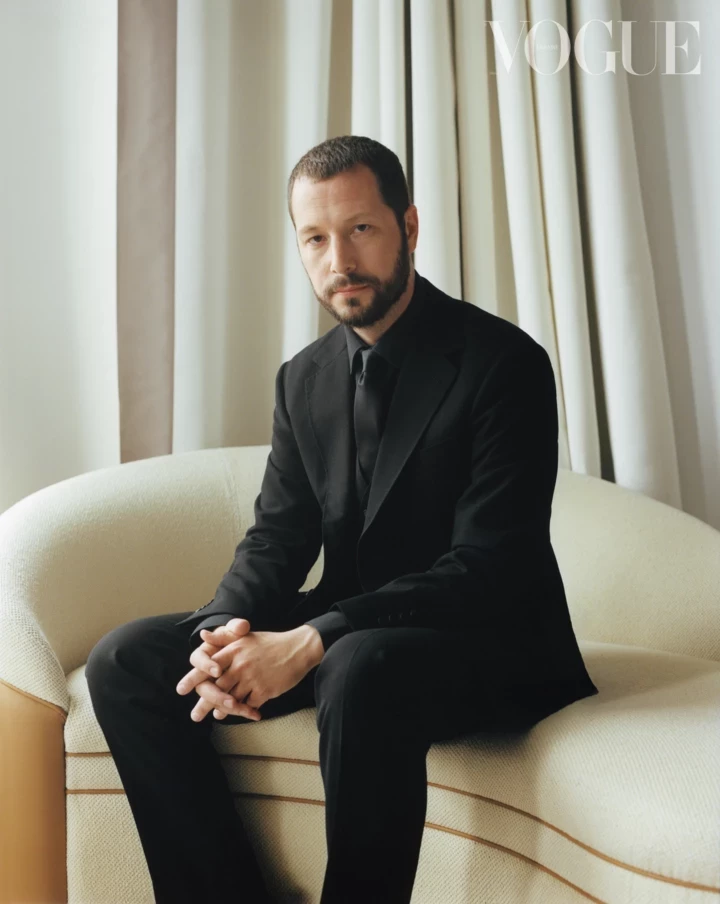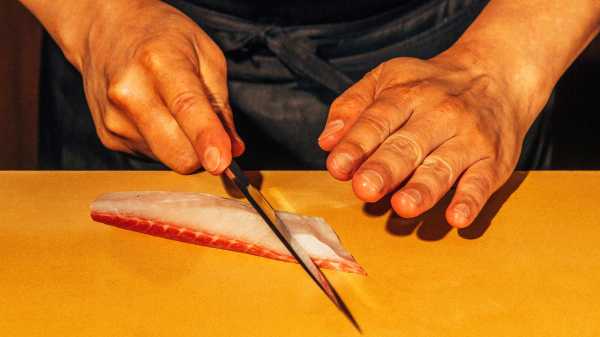
Save this storySave this storySave this storySave this storyYou’re reading the Food Scene newsletter, Helen Rosner’s guide to what, where, and how to eat. Sign up to receive it in your in-box.
On the corner of Thirty-first Street and Sixth Avenue, at the lower edge of the charmless, taxi-choked scrum of Herald Square, behind a veil of seemingly permanent scaffolding, there is a small brick building whose ground floor is occupied by a decent, fairly generic slice shop, next to which is a street-facing door that leads to the building’s upper floors. An unobtrusive little sign reads “Sendo,” the name of a sushi restaurant that opened a few months ago. You proceed up a narrow flight of steps, but Sendo’s door is unmarked; if you happen to overshoot, a hand-scrawled note taped to the wall of the fourth and final story helpfully reads “Sushi Bar 2nd Floor,” with an arrow pointing down. The restaurant, which takes no reservations, opens to customers at 5 p.m.; by the time I arrived one recent evening at 5:04, each of the counter’s twelve seats was already filled, and a little line had formed at the host’s podium.
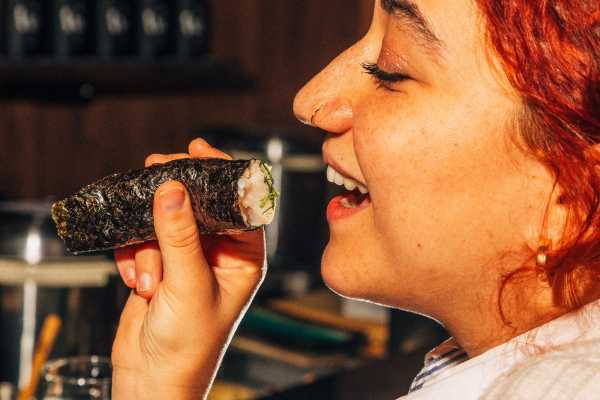
Hand rolls can be ordered à la carte once the omakase is complete.
All this secrecy and understatedness might make a person think she were in for something rarefied and, most likely, terribly expensive. Happily, Sendo offers something more reasonable. It bills itself as a “Tokyo-style” sushi-ya, which means that a meal there, if not quite fast and cheap, is certainly agile and inexpensive. The restaurant offers three omakase options, the priciest of which costs just forty-seven dollars and includes ten pieces of nigiri, two hand rolls, and a bowl of fish over rice. There are also prix-fixe sets of hand rolls, topping out at thirty-five dollars. Dinner might run as little as thirty minutes, but, with a few glasses of sake and an à-la-carte add-on or two, you could certainly stretch things out to a leisurely forty-five.
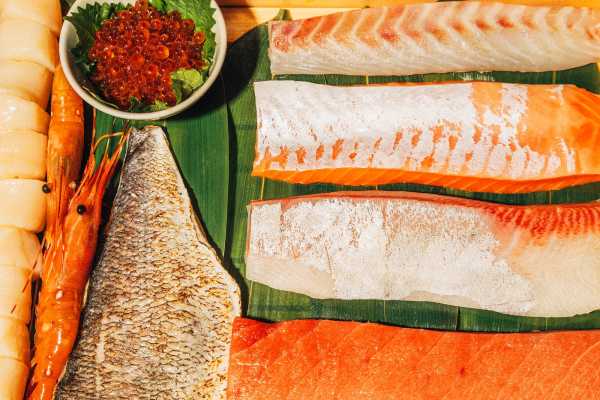
Raw fish awaits preparation on bamboo leaves, which also serve as diners’ plates.
Sendo is the creation of Guy Allen, an American and a sushi obsessive, in partnership with a cohort of investors in Japan. The Tokyo restaurants on which Sendo is modelled tend to be standing counters, but here Allen has (thankfully) opted for bar-height chairs and a tight crew of waitstaff. The chefs are a seasoned team of itamae who have worked at such revered spots as Sushi Nakazawa, Bar Masa, and Sushi Ginza Onadera. The omakase begins with a hand roll, then moves through a brisk, well-considered progression of nigiri, including bites of madai (sea bream), mild and clean-tasting; Spanish mackerel, with sweet ponzu sauce counterbalancing the fish’s gentle oiliness; two fat, shingled slices of scallop, with soy sauce marbling the creases; a firm, rosy-white piece of kampachi (a Japanese amberjack), with a big swash of wasabi; and a meltingly fatty piece of o-toro (tuna belly) as a climactic finish. A meal of such speed demands that the chefs move with conspicuous precision and efficiency. With minimal chitchat or dramatic flourish, they slice, they form, they assemble; then they place each finished bite on the large bamboo leaf that sits before each diner and serves as a plate, a lush slash of green against the dark countertop.
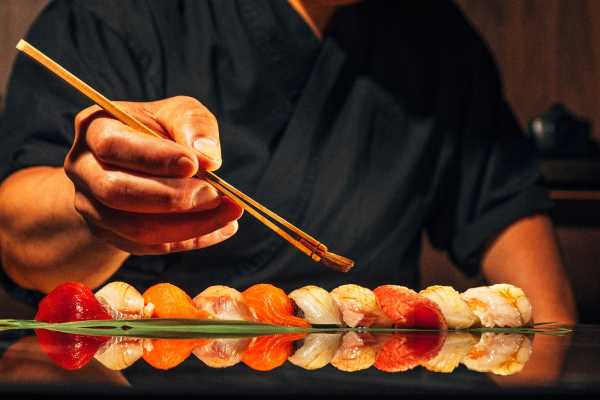
Pieces of nigiri.
At a certain level of execution, sushi is very much an art of marginal differences: the precise angle to which one chef might hone the blade of his knife, or the particular way another vinegars his rice. These are variations that might be imperceptible to the casual sushi eater but which can send a connoisseur into raptures. Sendo, like those stand-up Tokyo joints, isn’t operating at that haute-omakase calibre (in this sushi-obsessed city, that species of experience will run you many hundreds of dollars), but there are plenty of details here that indicate a level of sophistication that well surpasses the price point. The rice in the nigiri, imported from Hokkaido and seasoned with a house-made vinegar, is packed notably loosely, a high-end technique that maximizes surface area and therefore the flavor. Unagi (freshwater eel), too often served drowning in a syrupy sugar sauce, here is a large, creamy, smooth-fleshed fillet lightly basted with sweet tamari and broiled just to the edge of caramelization. Even the room feels a little bit rich, with dark walls, glossy wood panelling, and an austere display of sake bottles against the back of the sushi bar.
Helen, Help Me!
E-mail your questions about dining, eating, and anything food-related, and Helen may respond in a future newsletter.
This high quality-to-cost ratio is, I have to assume, thanks to a number of logistical factors, including the no-reservations policy and speedy pace of service, which insure that the counter is always full. (My wait time was about half an hour, but as I ate my meal I overheard the host quoting estimates of ninety minutes and more.) There’s also the relative savings that come from operating a restaurant above street level. In Japan, upstairs restaurants are so common as to be unremarkable, but it’s still oddly underplayed here in New York—with notable exceptions, such as the nearby stretch of Thirty-second Street that serves as the heart of Manhattan’s Koreatown, where bars and restaurants are stacked like pancakes. At Sendo, that single flight of stairs makes a world of difference, not only keeping the prices in check but also summoning a bit of the Tokyo experience and cultivating a sense of privacy, a bit of a clubhouse feel, a pleasing awareness that anyone who arrives at this unmarked door is a person unpretentiously in-the-know. A meal ends with kaisendon—mixed fish and a dollop of ikura, salmon roe, in a bowl with rice—followed by whatever à-la-carte nigiri or hand rolls you might want to add on from a supplemental list presented once the kaisendon is cleared away. All the classics are there, plus special cuts like shima aji (striped jack), which I especially loved for its citrus-bright flavor and almost al-dente firmness, and ankimo (monkfish liver), buttery and iodine. There’s no dessert. Keep things moving. Someone’s waiting for your seat. ♦
Sourse: newyorker.com


